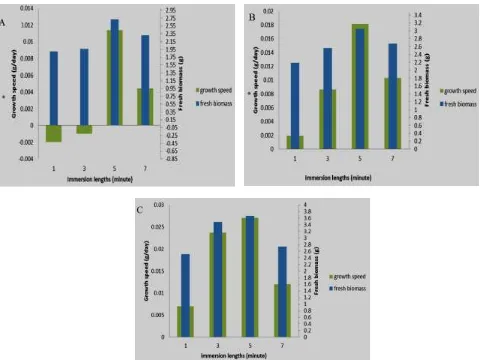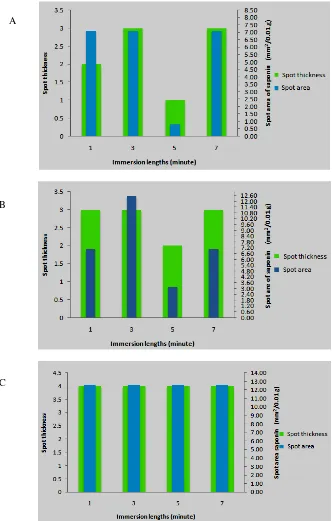www.saspublisher.com
Research Article
Production of Adventitious Root and Saponin of
Talinum paniculatum
(Jacq.)
Gaertn. in Temporary Immersion Bioreactor
Yosephine Sri Wulan Manuhara1*, Nike Oktavia Sri Saputri1, Alfinda Novi Kristanti2
1
Biology Department, 2Chemistry Department
Faculty of Science and Technology, Airlangga University, Surabaya, Indonesia *Corresponding author
Yosephine Sri Wulan Manuhara Email:
Abstract: This research is conducted to identify the effects of immersion length and interval on Talinum paniculatum (Jacq.) Gaertn adventitious roots’ biomass and saponin content in temporary immersion bioreactor. Immersion intervals used in this research are 3, 6, and 12 hours with immersion lengths 1, 3, 5, and 7 minutes. Adventitious roots were induced from leaf explants grown on MS medium added by IBA 2 mg/L. Two grams adventitious root are cultured in temporary immersion bioreactor with each treatment and kept for 28 days. Results of this research indicated different biomass and saponin content caused by each treatment. The best combination was found on immersion length of 5 minutes and 12 hours interval which resulting 3.67 g fresh weight, growth speed 0.027 g/day, spot area of saponin 12.56 mm2/0.01 g dry-weight, and spot area thickness scale 4+.
Keywords: adventitious roots, saponin, temporary immersion bioreactor, Talinum paniculatum (Jacq.) Gaertn
INTRODUCTION
Talinum paniculatum (Jacq.) Gaertn. is a herb with many medicinal properties. In Indonesia T. paniculatum known as ginseng Jawa and it roots’ contains β
-sitosteryl-β-D-glicosida known as pharmaceutical products
ingredient [1].
T. paniculatum adventitious root induction was successfully done using leaf explants on MS medium added by growth regulator substance IBA 2 mg/L. The disadvantage of using solid medium is that explants only absorb nutrition on the lower side which have direct contact with the medium, so that the result is less optimal compared to using liquid medium [2].
The use of liquid medium on plant tissue culture has some advantages. Liquid medium can provide homogenous culture condition, having faster growth rate, and relatively easy for sterilization [3-4]. However, there are several disadvantages of liquid medium mainly some technical issues such as hyperhydricity, cellular damage caused by propeller rotation when using bioreactor with churning system and oxygen deficiency [5]. Therefore, better methods to regulate aeration on the medium are needed. One of them is using temporary immersion applied to bioreactor known as Temporary Immersion Bioreactor (TIB) [6].
TIB is bioreactor which regulates nutrition and oxygen absorptions of the culture. In this condition, explants are not immersed in the medium all the time.
There are several periods when the explants are not immersed [6]. When the explants are not immersed, they are free to absorb oxygen because of low oxygen solubility on immersed condition. Oxygen is needed by culture to unload energy provided by medium in form of sucrose. TIB immersion lengths and intervals can help explants growth [7]. One to fifteen-minute immersion length with 2-12 hours of immersion frequency also affects explants growth of perennial plants [3].
When culture is on immersed condition as a result of one-minute immersion length and 1, 12, 24-hour of immersion intervals on TIB, may cause stress on Hevea brasiliensis calluses identified by superoxide dismutase (SOD) [8]. Immersion length and interval in culture could cause abiotic stresses. Abiotic stresses may affect production of secondary metabolite contents [9]. Secondary metabolite synthesis, including saponin is a response to abiotic stress [10]. For example water stress treatment on T. paniculatum plant increase its saponin content on water 40% availability [11].
MATERIAL AND METHODS Adventitious Roots Induction
Adventitious roots were induced from T. paniculatum leaf explants. T. paniculatum was obtained from the collection of Indonesian Institute of Sciences, Purwodadi Botanical Garden, Pasuruan, East Java, Indonesia. Leaf explants were cultured on Murashige and Skoog medium (1962) added by IBA 2 mg/L, sucrose 30 gram/L, and agar 12 gram/L. Culture were kept on dark condition at (25±3)C temperature for two weeks.
Adventitious Root Cultures on TIB
Two-week-old of adventitious roots cultured on solid medium were harvested and weighed as much as 2 grams. The cultures were then immersed in 400 mL liquid MS medium added by IBA 2 mg/L. After four weeks kept on TIB, adventitious roots were harvested and measured its fresh weight, dry weight, and growth speed. The growth speed was measured based on Akalezi [12].
Analysis of Saponin
Dried of adventitious roots (100 mg) were soaked in 10 mL ethanol, and then warmed in waterbath at 80oC for 30
minutes. Extract were saturated in waterbath at 80oC for 3 haours until the volume was obtained 0.2 mL. Extract and saponin standard were spotted on silica gel GF254 and
eluted in propanol:water (14:3). The spot was detected by anisaldehide-sulfic acid (Merck) and warmed in the oven at 110oC for 6-10 minutes. The saponin standars (Calbiochem) will give green to black color.
RESULTS AND DISCUSSION
Adventitious Roots Culture in Temporary Immersion Bioreactor
Adventitious roots growth in temporary immersion bioreactor was increased after being cultured for four weeks. It is indicated by increasing fresh biomass. Almost all of adventitious roots biomass increased, except for 3-hour immersion interval with 1 and 3-minute immersion lengths treatment. The highest biomass obtain was on 12-hour immersion interval with 5-minute immersion length. The improvement or reduction of fresh biomass is proportional to dry biomass improvement or reduction and growth speed (Figure 1).
Figure 1. Comparison of fresh biomass result and Talinum paniculatum adventitious roots growth speed on each treatment after being kept for 4 weeks in temporary immersion bioreactor using MS medium and IBA 2 mg/L. A:
On treatments with same immersion interval and different lengths, it indicated different biomass results. It may be caused by immersion lengths which determine contact time between explants and its media, so that the explants are able to absorb oxygen. On 1 and 3-minute of immersion length treatments, nutrition absorption by explants is not optimal, so that it only produces little biomass. Meanwhile, on 7-minute immersion length treatment, explants growth is limited. It is assumed that the most optimum absorption occurs on 5-minute immersion length, resulting high biomass.
The length of contact time between explants and its media on short interval treatments may cause slow growth speed. It may be caused by the frequency of immersion causing oxygen deficiency. This condition results low respiration rate, resulting low ATP obtained and slow growth rate.
Frequent explants immersion may inhibit oxygen absorption causing low biomass production as seen on 3-hour and 6-3-hour intervals. On 12-3-hour interval, the explants are not frequently immersed resulting optimal oxygen absorption and high biomass production.
On high intervals, explants indicated positive growth speed and relatively high growth rate. It may be caused by explants absorbing much oxygen when in not
being immersed condition resulting high respiration rate and more ATP produced used in cell growth. This finding conform the previous research conducted by Riyadi and Sumaryono [13] on sago somatic embryo growth using temporary immersion system which also finds that 12-hour immersion interval produced the highest fresh biomass.
The best immersion length and interval combination is found on 5-minute length and 12-hour interval immersion indicated by the highest biomass product. It is possibly because of nutrition and oxygen absorptions were optimum at this combination resulting optimal growth of adventitious roots. Different combinations of immersion length and intervals may result optimal growth because of optimal oxygen and nutrition absorptions [7]. Another possibility is because of water deficiency stress on the treatment. In this treatment explants only have contact with water twice a day. Roots growth will be faster in water stress condition compared to growth in water sufficient condition [14-16].
Saponin Content of Adventitious Roots
Saponin content of adventitious roots were indicated by dark green spot with Rf value 0.63 on TLC plate (Figure 2). Semiquantitatively, saponin content is determined by measuring the width and thickness of spot area (Figure 3).
Figure 2. Cromatogram of saponin on TLC plate. S: saponin standard, A: 1-minute immersion length in 3-hour interval, B: 1-minute immersion length in 6-hour interval, C: 1-minute immersion length in 12-hour interval, D: 3-minute immersion length in 3-hour interval, E: 3-3-minute immersion length in 6-hour interval, F: 3-hour immersion length in 12-hour interval, G: 5-minute immersion length in 3-hour interval, H: 5-minute immersion length in 6-hour interval, I: 5-minute immersion length in 12-hour interval, J: 7-minute immersion length in 3-hour interval, K: 7-minute immersion length in 6-3-hour interval, L: 7-minute immersion length in 12-3-hour interval.
The longer immersion interval, the higher saponin content resulted. It may be caused by less contact between root and the medium resulting water and nutrition deficiencies on explants. However, referring to high
Synthesis of saponin is initiated by glycolysis process which results pyruvic acid. Pyruvic acid is oxidized into acetyl CoA. Acetyl CoA is the source of Carbon on the synthesis of saponin (Manitto, 1992). Acetyl CoA is synthesized into mevalonic acid which release its CO2 resulting isoprenoid. Six isoprenoid
compounds are condensed resulting squalene. Squalene
undergoes cyclisation process into terpenoid compounds. The terpenoid compounds will bind with glucose to form saponin [17].
Saponin content of T. paniculatum adventitious root culture is in proportion with its biomass. This phenomenon was coincide with production of biomass and saponin content of Panax ginseng in TIB [18].
Figure 3. Comparison of adventitious roots saponin spot area and thickness on TLC. A: 3-hour interval, B:6-hour interval, C: 12-B:6-hour interval
A
B
CONCLUSION
The highest biomass and saponin content of Talinum paniculatum adventitious roots on liquid culture using temporary immersion bioreactor method is obtained in combination of 5-minute immersion length and 12-hour immersion interval.
REFERENCE
1. Komatsu M, Ichiro Y, Yoshiaka S, Tomimarri T; Stusies on Constituent Talinum paniculatum Gaertn. Yakugaku Zasshi, 1982; 102(5):499-502. mass propagationIn Liquid Culture Systems for in vitro Plant Propagation, Anne K.H.E. and Walter P(eds), Springer : Netherlands. 2005; 165-195. 4. Gupta PK, Timmis R; Mass propagation of conifer
trees in liquid cultures - progress towards commercialization In: Liquid Culture Systems for in vitro Plant Propagation, Anne K.H.E. and Walter P (eds), 2005; 389–402 Springer : Netherlands.
5. Preil, W; General introduction: a personal reflection on the use of liquid media for in vitro In culture Liquid Culture Systems for in vitro Plant Propagation, Anne K.H.E. and Walter P (eds).Springer : Netherlands. 2005;1-8.
6. Be LV, Tan VT, Uyen NTT, Dung LV; Low-cost micropropagation of vetiver (Vetiveria zizanioides L.), Assumption University Journal of Technology, 2008; 12(1):1–101.
7. Ducos JB, Terrier B, Courtois D; Disposable bioreactors for plant micropropagation and mass plant cell culture, National Center for Biotechnology Information, Advances in Biochemical Engineering/Biotechnology, 2009;115:89-115.
8. Martre P, Lacan D, Just D, Teisson C; Physiological effects of temporary immersion on Hevea brasiliensis callus, Kluwer Academic
Publishers, Plant Cell, Tissue and Organ Culture, 2001; 67: 25–35.
9. Sharma M, Sharma A, Kumar A, Basu SK; Enhancement of secondary metabolites in cultured plant cells through stress stimulus, Academic Journals, American Journal of Plant Physiologi, 2011; 6(2):50-71.
10. Ramakrishna A, Ravishankar GA; Influence of abiotic stress signals on secondary metabolites in plants, Landes Bioscience, Plant Signaling & Behavior, 2011; 6(11): 720-1731.
11. Anggar SE, dan Widya MW; Pengaruh Ketersediaan air terhadap pertumbuhan dan kandungan bahan aktif saponin tanaman Ginseng Jawa (Talinum panicullatum Gaerth), Biofarmasi, 2005; 3(2):47-51.
12. Akalezi CO, Liu S, Li QS, Yu JT, Zhong JJ; Combined effect of initial sucrose concentration and inoculum size on cell growth and ginseng saponin production by suspention culture Panax ginseng. Process Biochemistry, 1999; 34: 639-642. 13. Riyadi I, Sumaryono; Pengaruh interval dan lama
perendaman terhadap pertumbuhan dan pendewasaan embrio somatik tanaman sagu (Metroxylon sagu Rottb.), Menara Perkebunan, 2009; 77(2):101-110.
14. Federenco DEF, Fernandez OA, Busso GA; The effect of water stress on top and root growth in Medicago minima, Jurnal of Arid Environment, 1995; 29:47-54.
15. Steven CG; Importance of root growth in overcoming planting stress, Springer, New Forests, 2005; 30:273–294.
16. Bengough AG, Kenzie MBM, Hallett PD, Valentine TA; Root elongation, water stress, and mechanical impedance: a review of limiting stresses and beneficial root tip traits, Journal of Experimental Botany, 2011; 62(1):59-68
17. Hopkins WG, Huner NPA; Introduction to Plant Physiology ,Fourth Edition, John Wiley & Sons : USA. 2008.

